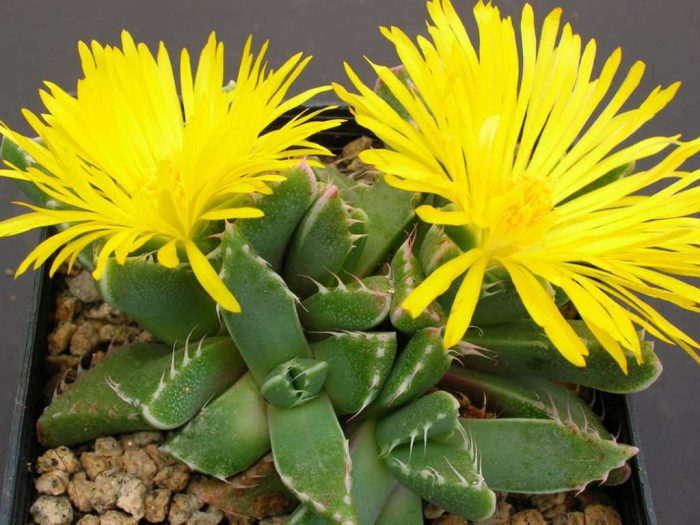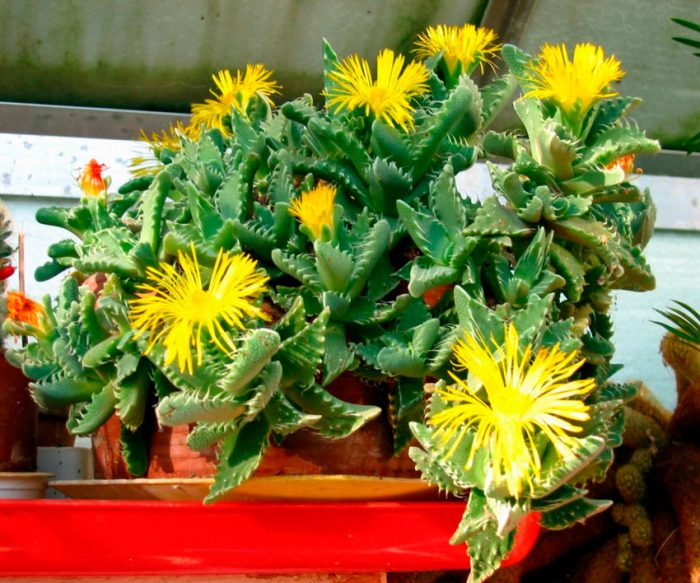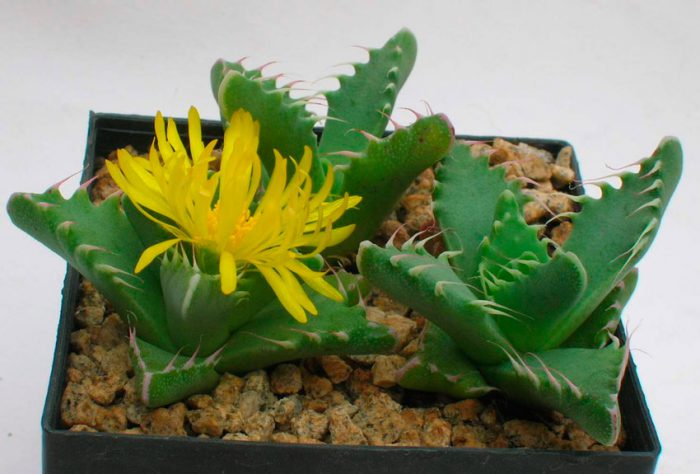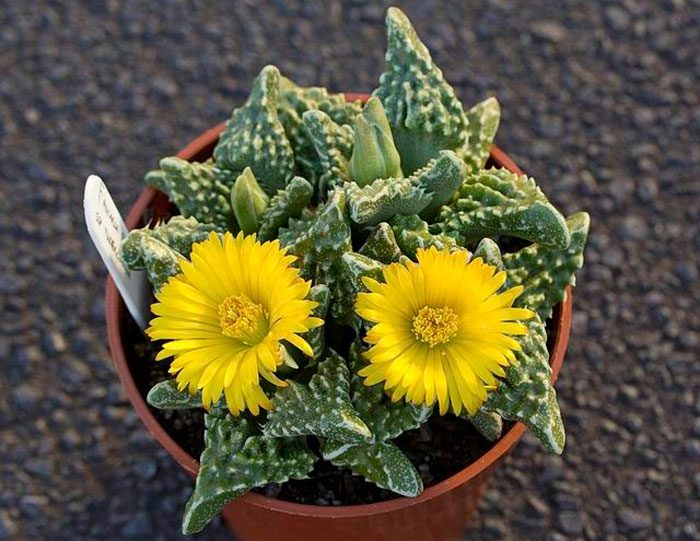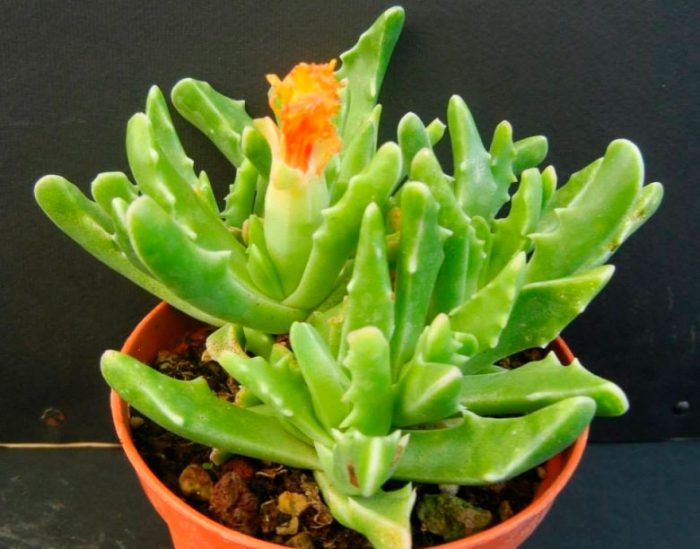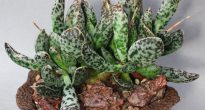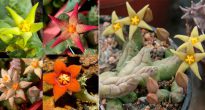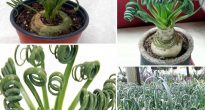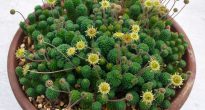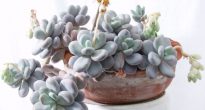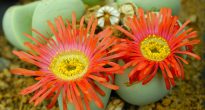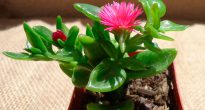Such a succulent as faucaria (Faucaria) is directly related to the Aizoaceae family. This plant comes from the arid regions of South Africa. Faucaria is translated from Latin "faux" - "mouth" and from Greek "αρι" - "many". This is due to the type of plant itself. So, its leaves end in spinous outgrowths, which are similar to the jaw of a predatory animal.
Such a plant is a perennial. It has a short fleshy rhizome and a shortened stem. As a rule, over time, it grows strongly and can form whole clumps, which include many stems. Each leaf rosette includes from 3 to 6 pairs of juicy and rather thick leaves, which are arranged crosswise. They can be painted in various colors, both dark and pale green, with whitish specks or strokes. At the edges of the leaves, spinous outgrowths or hair-like teeth are located. Single flowers are rather large, so their diameter can reach 6-7 centimeters. They have a large number of petals, which are colored in different shades of yellow. Flowers bloom during the daytime, while they close at night. Each flower lasts about 6-8 days.
Faucaria care at home
Illumination
Lighting must be bright, so it is recommended to put the flower on the sill of the south window. If there is little light, then the leaf rosettes will become loose.
Temperature regime
The optimum temperature in summer is from 25 to 30 degrees. It is worth remembering that in the summer such a plant can withstand any temperature fluctuations. In winter, it needs coolness (about 10 degrees).
Humidity
Faucaria is quite suitable for living in conditions of low humidity in city apartments. She does not need additional hydration. For hygiene reasons, it is recommended to regularly wipe the surface of the sheet plates.
How to water
Water should be moderate in spring and summer. So, it is recommended to water it only after the soil is completely dry. In autumn, watering should be more scarce. In winter, dry content without watering is recommended.
Top dressing
Top dressing is carried out in April – August 1 time per 4 weeks. For this, fertilizers are used for cacti.
Transplant features
The transplant is carried out once every 2 years. Suitable soil should be loose and breathable. To prepare the soil mixture, it is necessary to combine the sod and leafy land with river sand (1: 1: 1). A commercial ready-made substrate for succulents and cacti is also suitable. The pot should be low but wide. During planting, a good drainage layer must be made at the bottom.
Reproduction methods
Can be propagated by shoots and seeds.
Seeds are sown on the surface of coarse sand, while they are only slightly sprinkled with soil. Put glass on top. The suitable temperature is 20 to 25 degrees. The sand should not dry out, for this it should be moderately moistened with a sprayer. The first seedlings will appear after 1-1.5 weeks. The pick is made after the appearance of the 1st pair of leaves. For planting, use the soil for cacti.
Separate the cutting and leave in the open air for 2-3 days to dry. After that, it is planted in sand and maintained at a fairly high temperature from 25 to 28 degrees. Full rooting will occur after 3-4 weeks.
Pests and diseases
Sufficiently resistant to diseases and pests. If the plant is weakened, then it can settle on aphid either root mealybug... If the rules of care are violated, the formation of gray rot is possible.
Possible difficulties
- Blanching foliage, elongated shoots - warm wintering, poor lighting.
- Shriveled, blackened leaves - overflow (especially in winter).
- The leaf plates are pale, wrinkled and small, the plant has stopped growing - needs feeding, overdrying of the soil. However, this condition is normal in winter.
- Brown spots formed on the surface of the foliage - sunburn.
Main types
Faucaria feline (Faucaria felina)
This succulent can reach a height of 10-15 centimeters. The leaf plate is about 5 centimeters long and 1.5 centimeters wide. Saturated green leaves are arranged oppositely, crosswise. On their surface there are whitish blurred points, and at the edges there are 3-5 bent teeth, which turn into a bristle. Golden yellow flowers reach 5 centimeters in diameter.
Faucaria small-toothed (Faucaria paucidens)
This succulent has leaves of a pale green color, which reach 5 centimeters in length and are centimeter wide. On the surface of the leaf plate there are points of dark green color, and on the edges there are from 1 to 3 teeth. The yellow flowers can be up to 4 centimeters in diameter.
Faucaria fine (Faucaria speciosa)
This succulent has fleshy leaves that reach 3 centimeters in length. Along the edge there are 5 or 6 teeth of a rather large size, which turn into a bristle. The flowers are quite large, so their diameter is 8 centimeters. They are colored golden yellow, while the ends of the petals have a purple tint.
Faucaria tiger (Faucaria tigrina)
This succulent plant reaches a height of only 5 centimeters. Rhombic greenish-gray leaves have a sharpening at the tips. On their surface there are many whitish dots arranged in stripes, while along the edges there are 9 or 10 pairs of strong teeth bent back, which have hair-like ends. The golden-yellow flowers reach 5 centimeters in diameter.
Faucaria tuberculosa (Faucaria tuberculosa)
In height, such a succulent can reach from 5 to 8 centimeters, while it has a branching stem. Dark green, jagged, fleshy leaves are arranged opposite and at the same time grow together at the bases. The shape of the leaf plate is almost triangular or rhombic, while whitish warts are located on its surface. Yellow flowers reach 4 centimeters in diameter.

